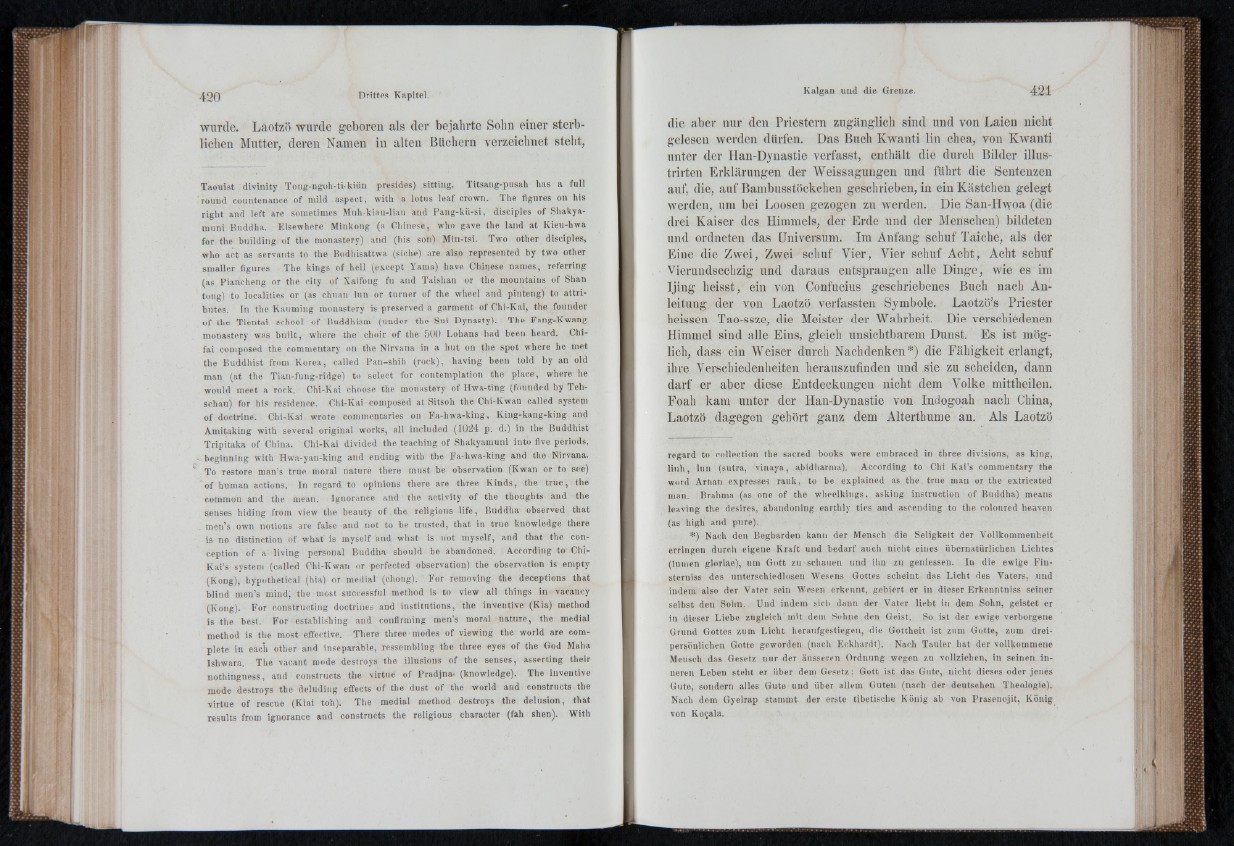
wurde. Laotzij wurde geboren als der bejahrte Sohn einer sterb-
lichen Mutter, deren Namen in alten Btlchern verzeichnet steht,
Taouist divinity Tong-ngoh-ti-kiiin presides) sitting. Titsang-pusah has a full
round countenance of mild aspect, with a lotus leaf crown. The figures on his
right and left are sometimes Muh-kiau-lian and Pang-kii-Si, disciples of Shakya-
muni Buddha. Elsewhere Minkong (a Chinese, who gave the land at Rieu-hwa
for the building of the monastery) and (his son) Min-tsi. Two other disciples,
who act as servants to the Bodhisattwa (siche) are also represented by two other
smaller figures The kings of hell (except Yama) have Chinese names, referring
(as Piahcheng or the city of Xaifoug fu and Taishan or the mountains of Shan
tong) to localities or (as chiian lun or turner of the wheel and pinteng) to attributes.
In the Kauming monastery is preserved a garment of Chi-Kai, the founder
of the Tientai school of Buddhism (under the Sui Dynasty). The Fang-Kwang
monastery was b u ilt, where the choir of the 500 Lohans had been heard. Chi-
fai composed the commentary on the Nirvana in a hut on the spot where he met
the Buddhist from Korea, called Pau-shih (rock), having been told by an old
man (at the Tian-fung-ridge) to select for contemplation the place, where he
would meet a rock. Chi-Kai choose the monastery of Hwa-ting (founded by Teh-
schau) for his residence. Chi-Kai composed at Sitsoh the Chi-Kwan called system
of doctrine. Chi-Kai wrote commentaries on Fa-hwa-king, King-kang-king . and
Amitaking with several original works, all included (1024 p. d.) in the Buddhist
Tripitaka of China. Chi-Kai divided the teaching of Shakyamuni into five periods,
beginning with Hwa-yan-king and ending with the Fa-hwa-king and the Nirvana.
To restore man’s true moral nature there must be observation (Kwan or to see)
of human actions. In regard to opinions there are three Kinds, the tru e , the
common and the mean. Ignorance and the activity of the thoughts and the
senses hiding from view the beauty of the. religious life , Buddha observed that
men’s own notions are false and not to be trusted, that in true knowledge, there
is no distinction of what is myself and what is not myself, and that the conception
of a living personal Buddha should be abandoned. According to' Chi-
Kai’s system (called Chi-Kwan or perfected observation) the observation is empty
(Kong), hypothetical (hia) or medial (chong). For removing the deceptions that
blind men’s mind; the most successful method is to view all things in vacancy
(Koug)i For constructing doctrines and institutions, the inventive (Kia) method
is the best. For establishing and confirming men’s moral natnre, the medial
method is the most effective. There three modes of viewing the world are complete
in each other and inseparable, ressembling the three eyes of the God Maha
Ishwara. The vacant mode destroys the illusions of the senses, asserting their
nothingness, and constructs the virtue of Pradjna- (knowledge). The inventive
mode destroys the deluding effects of the dust of the world and constructs the
virtue of rescue (Kiai toh). The medial method destroys the delusion, that
results from ignorance and constructs the religious character (fah shen). With
die aber nur den Priestern zugänglich sind und von Laien nicht
gelesen werden dürfen. Das Buch Kwanti lin chea, von Kwanti
unter der Han-Dynastie verfasst, enthält die durch Bilder illus-
trirten Erklärungen der Weissagungen und führt die Sentenzen
auf, die, auf Bambusstöckchen geschrieben, in ein Kästchen gelegt
werden, um bei Loosen gezogen zu werden. Die San-Hwoa (die
drei Kaiser des Himmels, der Erde und der Menschen) bildeten
und ordneten das Universum. Im Anfang schuf Taiche, als der
Eine die Zwei, Zwei schuf Vier, Vier schuf Acht, Acht schuf
Vierundsechzig und daraus entsprangen alle Dinge, wie es im
Ijing heisst, ein von Confucius geschriebenes Buch nach Anleitung
der von Laotzö verfassten Symbol.e. Laotzö’s Priester
heissen Tao-ssze, die Meister der Wahrheit. Die verschiedenen
Himmel sind alle Eins, gleich unsichtbarem Dunst. Es ist möglich,
dass ein Weiser durch Nachdenken*) die Fähigkeit erlangt,
ihre Verschiedenheiten herauszufinden und sie zu scheiden, dann
darf er aber diese Entdeckungen nicht dem Volke mittheilen.
Foah kam unter der Han-Dynastie von Indogoah nach China,
Laotzö dagegen gehört ganz dem Alterthume an. Als Laotzö
regard to collection the sacred books were embraced in three divisions, as king,
liu h , lun (sutra, vinaya, a|3idharma). According to Chi Kai’s commentary the
word Arhan expresses rank, to be explained as the true man or the extricated
man. Brahma (as one of the wheelkings, asking instruction of Buddha) means
leaving the desires, abandoning earthly ties and ascending to the coloured heaven
(as high and pure).
*) Nach den Begharden kann der Mensch die Seligkeit der Vollkommenheit
erringen durch eigene Kraft und bedarf auch nicht eines übernatürlichen Lichtes
(lumen gloriae), um Gott zu schauen und ihn zu geniessen. In die ewige Finsterniss
des unterschiedlosen Wesens Gottes scheint das Licht des Vaters, .und
indem also der Vater sein Wesen erkennt, gebiert er in dieser Erkenntniss seiner
selbst den Sohn. Und indem sich dann der Vater liebt in dem Sohn, geistet er
in dieser Liebe zugleich mit dem Sohne den Geist, So ist der ewige verborgene
Grund Gottes zum Licht heraufgestiegen, die Gottheit ist zum Gotte, zum dreipersönlichen
Gotte geworden (nach Eckhardt). Nach Tanler hat der vollkommene
Mensch das Gesetz nur der äusseren Ordnung wegen zu vollziehen, in seinen inneren
Leben steht er über dem Gesetz; Gott ist das Gute, nicht dieses oder jenes
Gute, sondern alles Gute und über allem Guten (nach der deutschen Theologie).
Nach dem Gyelrap stammt der erste tibetische König ab von Prasenojit, König
von Koijala.